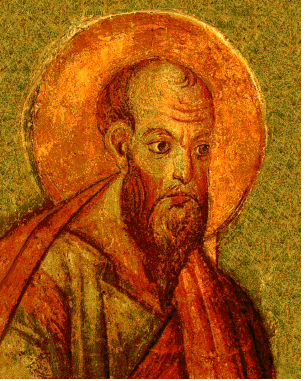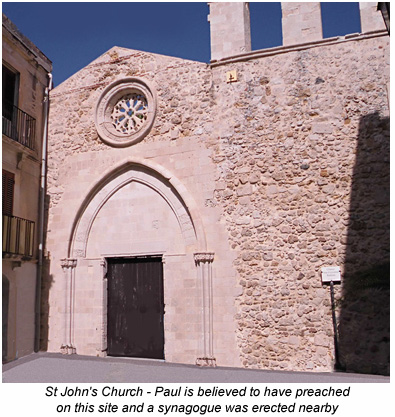...Best of Sicily presents... Best of Sicily Magazine. ... Dedicated to Sicilian art, culture, history, people, places and all things Sicilian. |
by Vincenzo Salerno | |||
Magazine Index Best of Sicily Arts & Culture Fashion Food & Wine History & Society About Us Travel Faqs Contact Map of Sicily
|
The facts of Paul's life and writings, about which volumes have been authored by historians as well as theologians, are well known. Briefly, he was born Saul in Tarsus in Asia Minor (now Turkey) into a prosperous Jewish family. Studying in Palestine, he came into contact with the earliest followers of Jesus, most of whom were former Jews. The erudite Saul initially scorned these people, but he eventually became convinced of their beliefs after being temporarily blinded while travelling the road to Damascus. Though Paul never met Jesus in life, he saw the resurrected Christ during this metanoia (conversion in belief) around the year AD 33 (33 CE). Paul eventually met Simon Peter, Jesus' first apostle. Known as the "Apostle to the Gentiles," Paul preached far and wide, in regions that included Jordan, Syria, Cilicia, Cyprus, Greece and Asia Minor, in a ministry which existed apart from the corpus of the disciples at Jerusalem, who he met around the year 49 to discuss matters relating to the conversion of Gentiles. Paul's occasional differences with Peter and others are well known. Around 50 Paul began eighteen months preaching in Corinth. He then travelled to Ephesus, where he lived for about two years. Following this, he visited Macedonia and returned to Corinth before his last visit to Jerusalem around 57. There he was imprisoned for two years based on complaints from hostile - and perhaps jealous - Jews. Exercising his rights to justice as a Roman citizen, Paul requested Rome as the venue for his trial. This request was granted. En route to Rome he was shipwrecked on Malta, possibly around the rocky islets and bay that bear his name. He stayed on the island for three months. Though a prisoner, Paul (as a Roman citizen accused of non-violent crimes) seems to have enjoyed a great degree of personal freedom during his voyage to the trial scheduled to take place in the capital. On Malta he preached in a cave in what is now Rabat, near Melita (now Mdina), and was on good terms with the governor Publius, who he converted.
The description of this journey is found in Acts of the Apostles, 28:11-13. "After three months we put out to sea in a ship that had wintered on the island. It was an Alexandrian ship with the figurehead of the twin gods Castor and Pollux. We put in at Syracuse and stayed there three days. From there we set sail and arrived at Rhegium. The next day the south wind came up, and on the following day we reached Puteoli." At Rome he lived under house arrest for two years. He was executed, possibly by decapitation, between 64 and 67. The church called "Saint Paul of the Three Fountains" was erected on what is traditionally identified as the site of his death. The sarcophagus containing what are believed to be his remains (and scientifically dated to the correct period) is kept at the church of Saint Paul Outside the Walls in Rome, and in 2009 the earliest known icon of Saint Paul (dated to circa AD 370) was discovered nearby in the Saint Thekla Catacombs; the fresco closely resembles the image shown on this page, the traditional depiction of Paul in both the Eastern (Orthodox) and Western (Catholic) churches. He is the heavenly patron of London and (with Peter) a patron of the city of Rome. About the Author: Palermo native Vincenzo Salerno has written biographies of several famous Sicilians, including Frederick II and Giuseppe di Lampedusa. | ||
Top of Page |
 Paul of Tarsus - known as Saint Paul
to most Christians - is one of the most important figures of early Christianity.
He is often identified with the time he spent in Rome following extensive
eastern and central Mediterranean travels, and known for the lengthy writings which
constitute an important part of the Bible's New Testament, notably
(but not exclusively) significant in their gentle yet dogmatic approach in defining
the ideal Christian lifestyle compared to the way Mediterranean peoples
had generally lived according to Jewish religious precepts and less sophisticated
Greek and Roman ones. A learned man, Paul was very clear in explaining that
Judaism had prepared humanity for Christianity, and he had a definite knowledge
of the ideas of Greek philosophers such as Plato. Eclectic though theologians'
opinions of Paul may be (they even argue over attribution of certain
letters to his authorship), it is generally agreed that he stands alone among New Testament writers
in expressing what could be regarded as a cohesive, thoughtful, understandable "philosophy" of Christianity.
Paul of Tarsus - known as Saint Paul
to most Christians - is one of the most important figures of early Christianity.
He is often identified with the time he spent in Rome following extensive
eastern and central Mediterranean travels, and known for the lengthy writings which
constitute an important part of the Bible's New Testament, notably
(but not exclusively) significant in their gentle yet dogmatic approach in defining
the ideal Christian lifestyle compared to the way Mediterranean peoples
had generally lived according to Jewish religious precepts and less sophisticated
Greek and Roman ones. A learned man, Paul was very clear in explaining that
Judaism had prepared humanity for Christianity, and he had a definite knowledge
of the ideas of Greek philosophers such as Plato. Eclectic though theologians'
opinions of Paul may be (they even argue over attribution of certain
letters to his authorship), it is generally agreed that he stands alone among New Testament writers
in expressing what could be regarded as a cohesive, thoughtful, understandable "philosophy" of Christianity. Chronologies of Paul's life are approximate and debated by scholars.
At some point around the year 59 he visited
Chronologies of Paul's life are approximate and debated by scholars.
At some point around the year 59 he visited